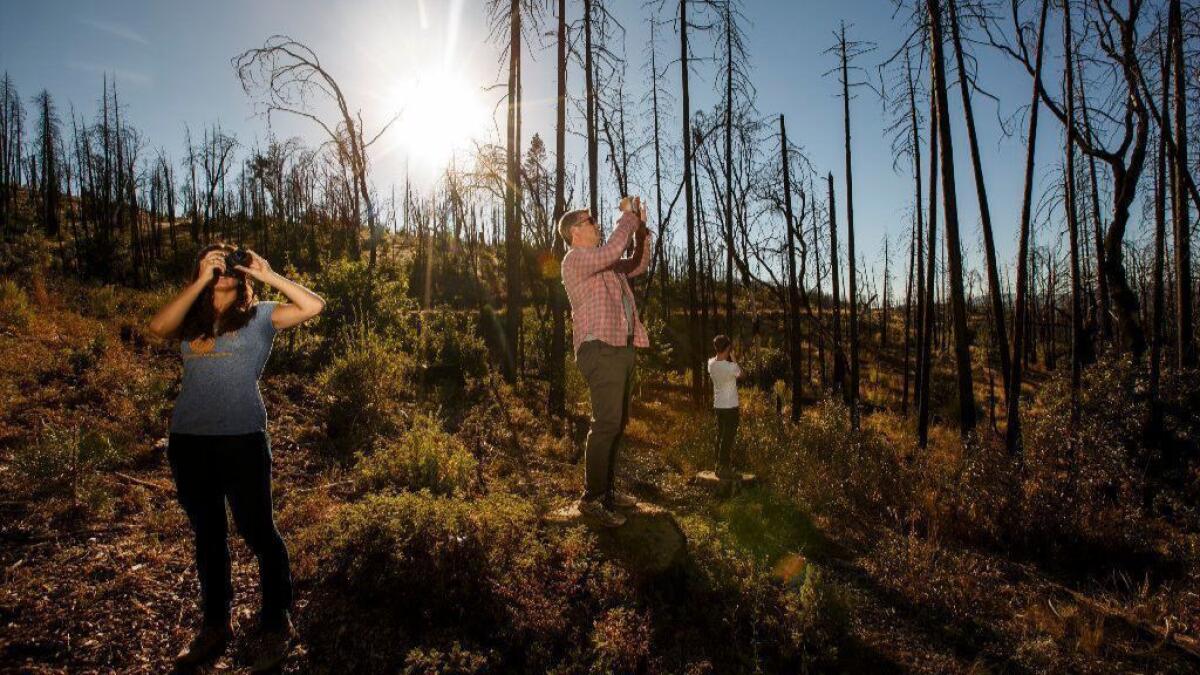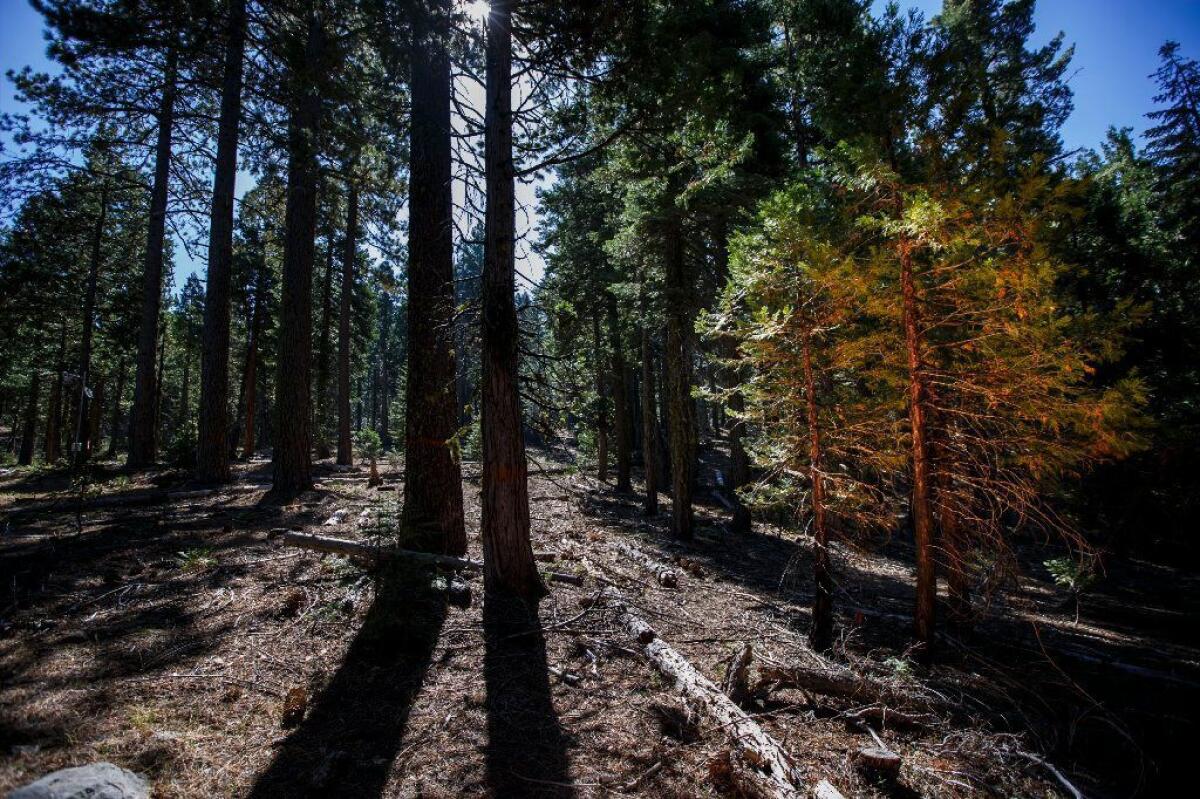Start-up Blue Forest secures funding for first privately financed forest fire bond

- Share via
In a remote corner of the Sierra Nevada, amid 8,000-foot peaks and deep river gorges, a financial experiment is about to begin.
Once this winter’s snow melts, workers will cut down small trees and burn off undergrowth across 5,000 acres of the Tahoe National Forest. But those workers won’t be paid by the U.S. Forest Service or any other public agency that typically funds forestry projects.
Instead, the roughly $4 million will come from two foundations, an investment firm and an insurance company — which hope to make money on the deal.
The project, set to begin next summer, is the first forestry project financed with a so-called “forest-resilience bond” created by the nonprofit World Resources Institute and start-up Blue Forest Conservation. The San Francisco firm was founded by a group of Berkeley business school graduates with the goal of persuading profit-seeking investors to pay for work that reduces the risk of costly wildfires and potentially eases the risk of drought. Blue Forest finalized terms with its investors on Wednesday.
The Tahoe project is a big deal for Blue Forest and marks the culmination of more than three years of work. But it’s also a first step, one the company’s founders hope will ultimately lead to much larger projects costing tens of millions of dollars and covering vast swaths of overgrown, fire-prone forests in California and other Western states.
“Just signing the contract is already a success,” said Leigh Madeira, a Blue Forest founder. “But we don’t want to be doing just one project. We want to be doing this on a bigger scale in multiple watersheds in multiple states.”
The forest resilience bond works like this:
Investors put up the cash to pay for forest-thinning work. They’ll be repaid over time, with interest, by public agencies or other entities that want to see that work done but can’t pay for it all at once.
In this case, the roughly $4 million in upfront money is coming from CSAA Insurance Group — part of AAA — and investment firm Calvert Impact Capital, as well as the Rockefeller Foundation and the Gordon and Betty Moore Foundation. They’ll be lending that money to the National Forest Foundation, which will hire the contractors and manage the forestry work. CSAA and Calvert will earn 4% on their money — richer than the 3% they might earn on government bonds — while the foundations will earn 1%.
The money to repay the bonds will come from annual payments from the Yuba Water Agency, a public water utility, and a grant from the California Department of Forestry and Fire Protection, also known as CalFire.
For the investors, the appeal of the fire bond is more than just the return on investment. Linc Walworth, vice president of investments for CSAA, said the insurance company last year alone had 5,000 wildfire-related insurance claims. Investing in a healthier forest could mean having to pay fewer claims.
“To the extent we can reduce the risk of wildfire in California, that’s good business for us,” he said.
For Calvert, a Bethesda, Md., firm that specializes in so-called impact investments — ones that earn a financial return but that also aim to promote environmental stewardship, community development or other social benefits — the bond checked several boxes.
“There are air quality benefits, water quality benefits, job creation,” said Jacqueline Westley, a senior investment officer at Calvert. “It’s exactly the sort of thing we want to invest in.”
Just as important, though, there’s money lined up to repay the investors.
“They’ve built something we can channel capital to,” Westley said. “We see a lot of programs come across our desk that are not investable — they’re entirely too risky or there’s no source of repayment.”

A key benefit of the bond program is that, by using private financing on the front end, it allows work to happen now instead of waiting for public resources to become available. The U.S. Forest Service, which maintains the health of national forest land, has a backlog of tens of millions of acres’ worth of forest rehabilitation work that could cost billions of dollars to complete.
Jason Ko, a Forest Service program manager, said if it were left to his agency alone, the project being financed through Blue Forest would take between seven and 10 years to complete. With Blue Forest, it should be done in less than four.
“This would have waited until we had more money,” Ko said. “This allows us to do it now.”
Yuba Water, which has pledged $1.5 million over five years to help repay the bonds, is spending an unprecedented amount for a utility on a project of this type, said Sherry Reckler, a spokeswoman for the U.S. Forest Service’s California operations.
“This is the first time we’ve had a water agency willing to invest such a large sum,” she said.
The water agency hopes to get benefits from the project that could more than offset its financial contribution.
For starters, agency project manager Willie Whittlesey said thinning out this section of forest should mean less debris — branches and downed trees — washing down the North Yuba River, which runs from the project area down to the agency’s New Bullards Bar reservoir. And if the project prevents fires in the area, it should cut down on the amount of soil that washes into the river and its tributaries, as hillsides are more prone to erosion after fires.
Less debris and sediment can translate into big savings for Yuba Water. After heavy rains in the spring of 2017, the agency spent more than $5 million removing debris and sediment from its reservoirs.
CalFire already pays for forest-thinning work through grant programs aimed at reducing fire risk and protecting watersheds. But those grants are not paid out until work is completed, so the agency or nonprofit doing the work usually has to front the money itself, said Marcus Selig of the National Forest Foundation. That limits the amount of work the foundation and others can do.
On this project, a CalFire grant will ultimately cover much of the cost of the work, but it will be private investors, not the National Forest Foundation, that will pay for the work upfront.
“That frees up our resources so we can get more work done,” Selig said. “We do around $15 million to $20 million of work a year, and it’s not uncommon for us to get pretty strained.”
Whittlesey said Yuba Water was willing to pay into the program because it wants the fire bond idea to take off. If more utilities, other public agencies or companies that benefit from healthy forests pay for forestry work, it could defray the cost for all parties and lead to more work being done in less time.
“We need to identify all the beneficiaries and help them recognize the value of forest improvement work,” he said. “We’re willing to help launch this thing so we can show it works and hopefully identify other beneficiaries so we can do this on a larger scale throughout the watershed.”
Blue Forest hopes the Tahoe pilot project will help show that thinner forests use less water and allow more water to flow downstream. With enough data, co-founder Zach Knight said, Blue Forest may be able to persuade big water users — such as farms, breweries and beverage bottling companies — and power companies that generate electricity with hydroelectric dams to pay into future bond projects.
The company may even be able to sell carbon credits — the kind that are purchased by corporations looking to offset their carbon footprint — if it can quantify the carbon benefit of a forest that is less prone to burn.
“There is just so much interest from investors,” Madeira said. “Investors want to be funding things like this, but they don’t exist.”
Follow me: @jrkoren
More to Read
Inside the business of entertainment
The Wide Shot brings you news, analysis and insights on everything from streaming wars to production — and what it all means for the future.
You may occasionally receive promotional content from the Los Angeles Times.











